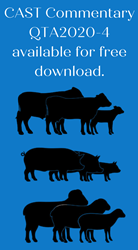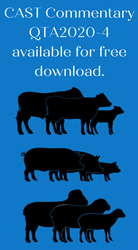
The use of production enhancing technologies is heavily regulated in the United States and across the world by multiple agencies resulting in an extremely safe food supply.
AMES, Iowa (PRWEB)
July 27, 2020
The Council for Agricultural Sciences and Technology (CAST) has released a new paper, “Impacts on Human Health and Safety of Naturally Occurring and Supplemental Hormones in Food Animals.” It is now available for download.
Since World War II, the United States has pursued a national policy of an abundant and inexpensive food supply. The average share of disposable personal income spent on total food by consumers in the U.S. from 1960 to 2018 fell from 16.8% to 9.7%. Since then, there has been a focus on improving nutrition, reproduction, genetics, and health and management practices. Feed additives, hormonal treatments, and growth enhancing technologies have also been studied and implemented by some producers. These technologies have reduced the costs of food production and the impacts of animal production on the environment.
Robert Collier and task force members assessed the use of hormones in animal agriculture and found that use of endocrine regulators to improve efficiency of growth, lactation, and reproduction has contributed significantly to providing a safe and low-cost food supply to American consumers. The intense regulatory scrutiny required to approve these products for use in animal agriculture has also contributed to the safety of the world’s food supply. For naturally occurring hormones, the FDA has concluded that no physiological effect could be expected in consumers eating animal products containing additional amounts of the hormone that is less than or equal to 1% of the amount produced by the human daily. None of the approved naturally occurring hormones in use produce residues in animal products that surpass this target level. For synthetic compounds, the use of production enhancing technologies is heavily regulated in the United States and across the world by multiple agencies resulting in an extremely safe food supply.
This paper covers the definition of hormones, sources of hormones in foods, hormones that are produced in plants or by molds, and hormones used in animal production for reproduction, growth, and lactation management. The authors also discuss the use of hormones to improve cow health, food safety oversight, and human exposure to hormone residues.
The commentary, “Impacts on Human Health and Safety of Naturally Occurring and Supplemental Hormones in Food Animals,” is available to download for free on CAST’s website. You can register here for the free webinar on Tuesday, July 28, Noon Central, when Robert Collier will share highlights of the publication, followed by a panel discussion and Q&A with several of the paper’s authors.
Task Force Authors:
- Robert J. Collier, University of Idaho
- Laura L. Hernandez, University of Wisconsin-Madison
- Jimena Laporta, University of Florida
- Jim Lauderdale, Upjohn/Pharmacia (retired)
- Zachary K. Smith, South Dakota State University
- John L. Vicini, Bayer Crop Science
About CAST
The Council for Agricultural Science and Technology is an international consortium of scientific and professional societies, companies, and nonprofit organizations. Through its network of experts, CAST assembles, interprets, and communicates credible, balanced, science-based information to policymakers, the media, the private sector, and the public.
Share article on social media or email:

